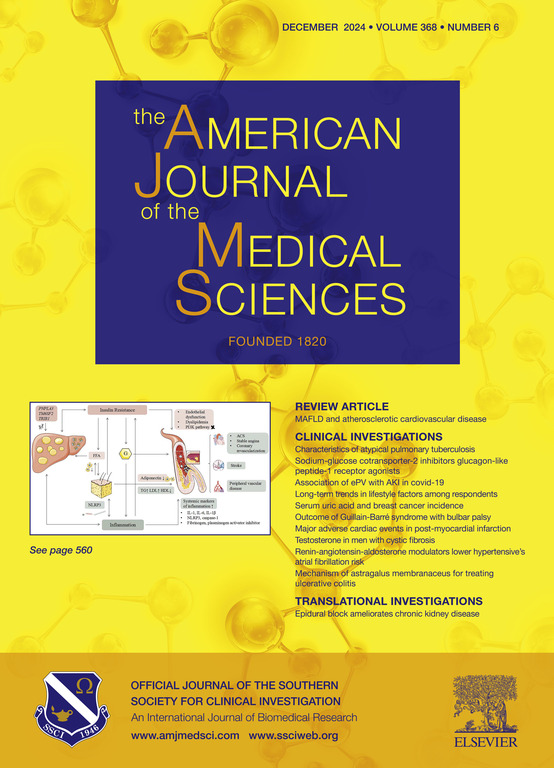Inflammation factors mediate the association between heavy metal and Homa-IR index: An integrated approach from the NHANES (2011∼2016)
IF 1.8
4区 医学
Q2 MEDICINE, GENERAL & INTERNAL
引用次数: 0
Abstract
Introduction
The interplay between heavy metals exposure and insulin resistance (IR), specifically through the mediation of inflammation factors, is crucial for understanding metabolic disturbances. This study utilizes data from the NHANES (2011∼2016) to investigate these relationships in a large, diverse U.S. population.
Methods
The study analyzed the associations between heavy metals (cadmium (Cd), lead (Pb), mercury (Hg), manganese (Mn)) and the Homeostatic Model Assessment for Insulin Resistance (Homa-IR) index. The analyses included descriptive statistics, Pearson's correlations, linear and non-linear regression models, and advanced statistical models such as Weighted Quantile Sum (WQS) regression and Bayesian Kernel Machine Regression (BKMR). Inflammation factors were assessed for their mediating role in these associations.
Results
The findings highlighted significant positive correlations between specific heavy metals and the Homa-IR index. Both linear and non-linear associations were evident, with certain metals showing a more pronounced impact in the presence of high inflammation markers. It was found that the Homa-IR index was negatively associated with Pb (β (95 %CI) = -0.0126 (-0.0238 ∼ -0.0015), P = 0.0268) and Hg (β (95 %CI) = -0.0090 (-0.0180 ∼ -0.0001), P = 0.0487). The WQS regression indicated an overall positive relationship between heavy metal mixtures (Estimate: 0.0050, P < 0.05) and the Homa-IR index where Cu had the highest weights (0.7741), while BKMR analyses detailed the varying effects of individual metals at different exposure levels. In the mediation analysis, it can be found that monocyte (Mono) mediated the association between Pb and Homa-IR index (direct effect:0.0546, indirect effect:0.0082) and neutrophil (Neu) (direct effect:0.0521, indirect effect:0.0047) can mediate the association between Hg and Homa-IR index.
Conclusions
This study confirms that exposure to heavy metals is associated with increased insulin resistance and that inflammation significantly mediates this relationship. Understanding these pathways is essential for developing targeted interventions to mitigate the metabolic consequences of environmental exposures.
炎症因子介导重金属与Homa-IR指数之间的关联:来自NHANES的综合方法(2011 ~ 2016)。
背景:重金属暴露与胰岛素抵抗(IR)之间的相互作用,特别是通过炎症因子的介导,对于理解代谢紊乱至关重要。本研究利用NHANES(2011 ~ 2016)的数据,在一个大而多样的美国人群中调查这些关系:方法:研究分析了重金属(镉(Cd)、铅(Pb)、汞(Hg)、锰(Mn))与胰岛素抵抗稳态模型评估(Homa-IR)指数之间的关系。分析方法包括描述性统计、Pearson相关、线性和非线性回归模型以及加权分位数和(WQS)回归和贝叶斯核机回归(BKMR)等高级统计模型。评估炎症因子在这些关联中的中介作用。结果:研究结果强调了特定重金属与Homa-IR指数之间的显著正相关。线性和非线性关联都很明显,某些金属在高炎症标志物存在时表现出更明显的影响。结果发现,Homa-IR指数与Pb (β (95%CI) = -0.0126 (-0.0238 ~ -0.0015),P=0.0268)和Hg (β (95%CI) = -0.0090 (-0.0180 ~ -0.0001),P=0.0487)呈负相关。WQS回归显示重金属混合物与胰岛素抵抗的总体正相关(估计值:0.0050,p)。结论:本研究证实重金属暴露与胰岛素抵抗增加有关,炎症显著介导了这一关系。了解这些途径对于制定有针对性的干预措施以减轻环境暴露的代谢后果至关重要。
本文章由计算机程序翻译,如有差异,请以英文原文为准。
求助全文
约1分钟内获得全文
求助全文
来源期刊
CiteScore
4.40
自引率
0.00%
发文量
303
审稿时长
1.5 months
期刊介绍:
The American Journal of The Medical Sciences (AJMS), founded in 1820, is the 2nd oldest medical journal in the United States. The AJMS is the official journal of the Southern Society for Clinical Investigation (SSCI). The SSCI is dedicated to the advancement of medical research and the exchange of knowledge, information and ideas. Its members are committed to mentoring future generations of medical investigators and promoting careers in academic medicine. The AJMS publishes, on a monthly basis, peer-reviewed articles in the field of internal medicine and its subspecialties, which include:
Original clinical and basic science investigations
Review articles
Online Images in the Medical Sciences
Special Features Include:
Patient-Centered Focused Reviews
History of Medicine
The Science of Medical Education.

 求助内容:
求助内容: 应助结果提醒方式:
应助结果提醒方式:


